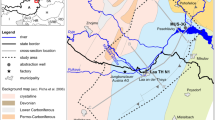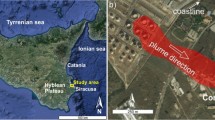Abstract
Deep injection disposal of liquid hazardous waste into aquifers confined from top and bottom by low permeable rock layers is examined. The injected waste represents aqueous solutions which are more dense than the reservoir water. Since the aquifer is not strictly horizontal, heterogeneity of the groundwater density causes a resultant buoyancy force which is directed down the dip of the aquifer. We considered a mathematical model of the contaminant plume movement taking into account both topography-driven (regional) and buoyancy induced components of the groundwater flow. Boussinesq’s approximation is used. A simple analytical solution, which is obtained by general functions theory, permits to determine conditions when the buoyancy forces suppress the regional flow what can substantially increase safety of the injection disposal. The obtained result is applied to analysis of contaminant plume movement at injection disposal site of liquid radioactive waste from Siberian Chemical Plant in Tomsk region. A numerical modeling of plume movement at the injection site is carried out. Heterogeneity of water transmissivity of the reservoir bed is taken into account as well as heterogeneous relief of its upper and lower boundaries. We showed on the basis of the analytical solution that buoyancy forces caused by elevated salinity of the injected waste and slope of the reservoir bed at the injection site exert a substantial influence on direction of the contaminant plume movement. Numerical modeling of contaminant plume movement is in good agreement with the analytical estimation of the buoyancy forces influence. Velocity of the regional groundwater flow is directed to the southwest of the injection site. However only dilute solutions are carried southwest by the regional flow. Dense solutions move westward because the buoyancy forces hamper southern component of the regional flow. This leads to an increase in travel time of a substantial part of the radionuclides to the river what increases safety of the injection site.






Similar content being viewed by others
References
Celli M, Barletta A, Longo S, Chiapponi L, Ciriello V, Di Federico V, Valiani A (2017) Thermal instability of a power-law fluid flowing in a horizontal porous layer with an open boundary: a two-dimensional analysis. Transp Porous Media 118:449–471
deMarsily G (1986) Quantitative hydrogeology. Academic Press, Orlando
Fried JJ (1975) Groundwater pollution: theory, methodology, modelling, and practical rules. Elsevier Scientific Pub. Co., Amsterdam
Gebhart B, Jaluria Y, Mahajan RP, Sammakia B (1988) Buoyancy-induced flows and transport. Hemisphere, Washington, DC
Glinskii ML, Pozdniakov SP, Chertkov LG, Zubkov AA, Danilov VV, Bakshevskaia VA, Samartsev VN (2014) Regional flow and transport simulation of liquid radioactive waste disposal at the Siberian chemical combine for long- and super-long-term postinjection periods. Radiochemistry 56:649–656
Guo B, Zheng ZH, Celia MA, Stone HA (2016) Axisymmetric flows from fluid injection into a confined porous medium. Phys Fluids 28:022107-1–022107-22
Hageman LA, Young DM (1981) Applied iterative methods. Academic Press, New York
Hinton EM, Woods AW (2018) Buoyancy-driven flow in a confined aquifer with a vertical gradient of permeability. Fluid Mech 848:411–429
Honeyman BD (1997) Colloidal culprits in contamination. Nature 397:23–24
Kersting AB, Efurd DW, Finnegan DL, Rokop DJ, Smith DK, Thompson JL (1999) Migration of plutonium in ground water at the Nevada Test Site. Nature 397:56–59
Malkovsky V (2011) Theoretical analysis of colloid-facilitated transport of radionuclides by groundwater. In: Kalmykov SN, Denecke MA (eds) Actinide nanoparticle research. Springer, Berlin, pp 195–243
Malkovsky VI, Pek AA (2009) Effect of colloids on transfer of radionuclides. Geol Ore Depos 51(2):79–92
Malkovsky VI, Pek AA, Velichkin VI, Parker FL (1999) Prediction of contaminant plume movement from the deep-well injection of liquid radioactive waste (LRW) at the Krasnoyarsk disposal site. Hydrol Sci Technol J 15:145–171
McCarthy J, Czerwinski KR, Sanford WE, Jardine PM, Marsh JD (1998) Mobilization of transuranic radionuclides from disposal trenches by natural organic matter. J Contam Hydrol 30:49–77
Nield DA, Bejan A (2013) Convection in porous media, 4th edn. Springer, New York
Nield DA, Kuznetsov AV, Barletta A, Celli M (2016) The onset of convection in a sloping layered porous medium: effects of local thermal non-equilibrium and heterogeneity. Transp Porous Media 114:87–97
Reid RC, Prausnitz JM, Sherwood Th K (1977) The properties of gases and liquids. McGraw-Hill, New York
Roache P (1976) Computational fluid dynamics. Hermosa Publishers, Albuquerque
Roy NC (2017) Theoretical approach to the onset of convection in a porous layer. Transp Porous Media 118:281–299
Rybalchenko AI, Pimenov MK, Kostin PP, Balukova VD, Nosukhin AV, Mikerin EI, Egorov NN, Kaimin EP, Kosareva IM, Kurochkin VM (1998) Deep injection disposal of liquid radioactive waste in Russia. Battelle Press, Columbus
Shestakov VM, Kuvaev AA, Lekhov AV, Pozdniakov SP, Rybalchenko AI, Zubkov AV, Davis PA, Kalinina EA (2002) Flow and transport modeling of liquid radioactive waste injection using data Siberian Chemical Plant injection site. Environ Geol 41:214–221
Vladimirov VS (1971) Equations of mathematical physics. M. Dekker, New York
Zakharova EV, Kaimin EP, Volkova AG, Zubkov AA, Rumynin VG, Sindalovsky LN (2007) Experimental and modeling studies of colloidal transport of radionuclides in aquifers (as applied to conditions of deep injection disposal of liquid RW at the disposal site of Siberian Chemical Combine): sorption of radionuclides on colloid particles. Geoekologiya 1:39–50 (in Russian)
Acknowledgements
This work was supported by Government financing.
Author information
Authors and Affiliations
Corresponding author
Additional information
Publisher’s Note
Springer Nature remains neutral with regard to jurisdictional claims in published maps and institutional affiliations.
Rights and permissions
About this article
Cite this article
Malkovsky, V.I., Yudintsev, S.V., Sharaputa, M.K. et al. Influence of buoyancy forces on movement of liquid radioactive waste from deep injection disposal site in the Tomsk region, Russian Federation: analytical estimate and numerical modeling. Environ Earth Sci 78, 219 (2019). https://doi.org/10.1007/s12665-019-8209-0
Received:
Accepted:
Published:
DOI: https://doi.org/10.1007/s12665-019-8209-0




